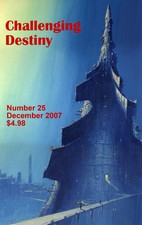


Reviews Home
Columns
Fiction by Title
Fiction by Author
Nonfiction
Movies by Title
Movies by Rating
Audio
Games
The Gold Coast, Kim Stanley Robinson, Orb, 1995, 389 pp. (originally published in 1988)
The Gold Coast forms the second volume of the Three Californias trilogy, and it could not seem more different than The Wild Shore, the book it follows. The Gold Coast's version of California is hyper-industrialized, hyper-urbanized, and no sane person's vision of utopia. Robinson slyly plays with this notion on the first page: "Night in Orange County, here, and the four friends are cruising in autopia" (1). The word "autopia" could be the easiest way to understand this book -- technology out of control, the needs of technology displacing human needs, etcetera. If only Robinson were that simplistic. As always, Robinson writes characters of astonishing depth, and the human story here demonstrates that life, in all its diverse splendour and horror, goes on. But what kind of life is it -- a sane, healthy life despite all the societal warping of accelerated progress and autopia? Wisely, Robinson leaves that question largely unresolved; his observer's eye is too keen to miss the complexity of any particular person's relation to the larger society. And The Gold Coast applies itself quite sharply to the problem of cultural change and the role of the individual in that change. Maybe more so than The Wild Shore, because of the greater similarities to our own culture in The Gold Coast. Post-apocalyptic stories simplify the issues somewhat, whereas The Gold Coast wrestles with all the contradictions, all the insanities.
The Gold Coast begins with a scene that echoes the opening scene of The Wild Shore -- a group of young people decide to dig up part of the past. But these are not graverobbers, these are a bunch of people who want to dig up a cornerstone of an old building for no particular reason. They are all also quite stoned. This group of friends are diverse, from Jim McPherson, the son of a worker in the military-industrial complex, to Sandy, the source of all the drugs that flow so freely in the book, to Abe, who works as emergency worker on the deadly freeways. The book follows their doings and misadventures in a deceptively episodic fashion. A number of conflicts form the basis of the book. Jim is rebelling against the life of his father, Dennis McPherson. Dennis has been a drone in the military-industrial complex for his entire life, and believes that his efforts are helping to end wars. This drives Jim to some extreme actions later on in the book. The book also follows the ups and downs of Jim's relationships with the opposite sex. He meets a woman named Hana, who does not quite fit into the flashy drugs and cars scene of Jim and his friends. Robinson uses Jim's decision about the relationship to conclude the book, which might be a bit stereotypical if it were not so deeply felt.
Stylistically, The Gold Coast is more flamboyant than The Wild Shore. This book is written in the present tense and plays with the narrative structure in a number of ways. While The Wild Shore had some self-reflexive narrative near the end as Hank told us about telling us the story, that book was largely conventional. The Gold Coast matches its subject matter with a kind of intensity that is entirely appropriate. We also get snatches of the poetry that Jim is writing (although that is not immediately apparent), and it is found poetry that actually seems poetic. Robinson also captures Jim's voice quite nicely in a completely different genre -- Jim is writing a history of Orange County. This history forms one of the backbones of the story, as we see the layers of tradition and change that have accumulated. This history is anything but boring.
The Gold Coast has some of the same considerations of what constitutes a satisfying or happy lifestyle/society as does The Wild Shore. I mentioned the word autopia earlier in my review, and the character of Abe is perhaps one of the human casualties. His life as a paramedic has its triumphs, but the sheer pace and number of accidents takes a massive toll on his well-being. Later on in the book, Jim goes for a long hiking trip, and the contrast between the back-to-nature life in the wilderness and Jim's normal life (fast cars, drugs, urban stress, etc.) was perhaps the silliest aspect of the book. Or at least the most simplistic. When Jim returns, he has an interesting conversation with his friend Tom. Tom had told Jim before of the wonders of nature, but Jim had not believed him; as Tom reports it: "'But you thought it was stupid. Bucolic reactionary pastoral escapism, you called it'" (383). At least Jim does not end the book by becoming a hermit. Interestingly, it's in the character of Tom that we also start to see a few parallels between the two books (The Wild Shore and The Gold Coast), although they are certainly not forced. In both books, Tom is an old man, who shares his wisdom with the younger generation, who gets sick and nearly dies, and so on. But the books work together best as the ideas collide and some of the same sensibilities get explored in the context of vastly different premises.
Last modified: March 15, 1999
Copyright © 1999 by James Schellenberg (james@jschellenberg.com)

Buy back issues of Challenging Destiny online from:
For the latest information on availability: Where Can You Buy Challenging Destiny?